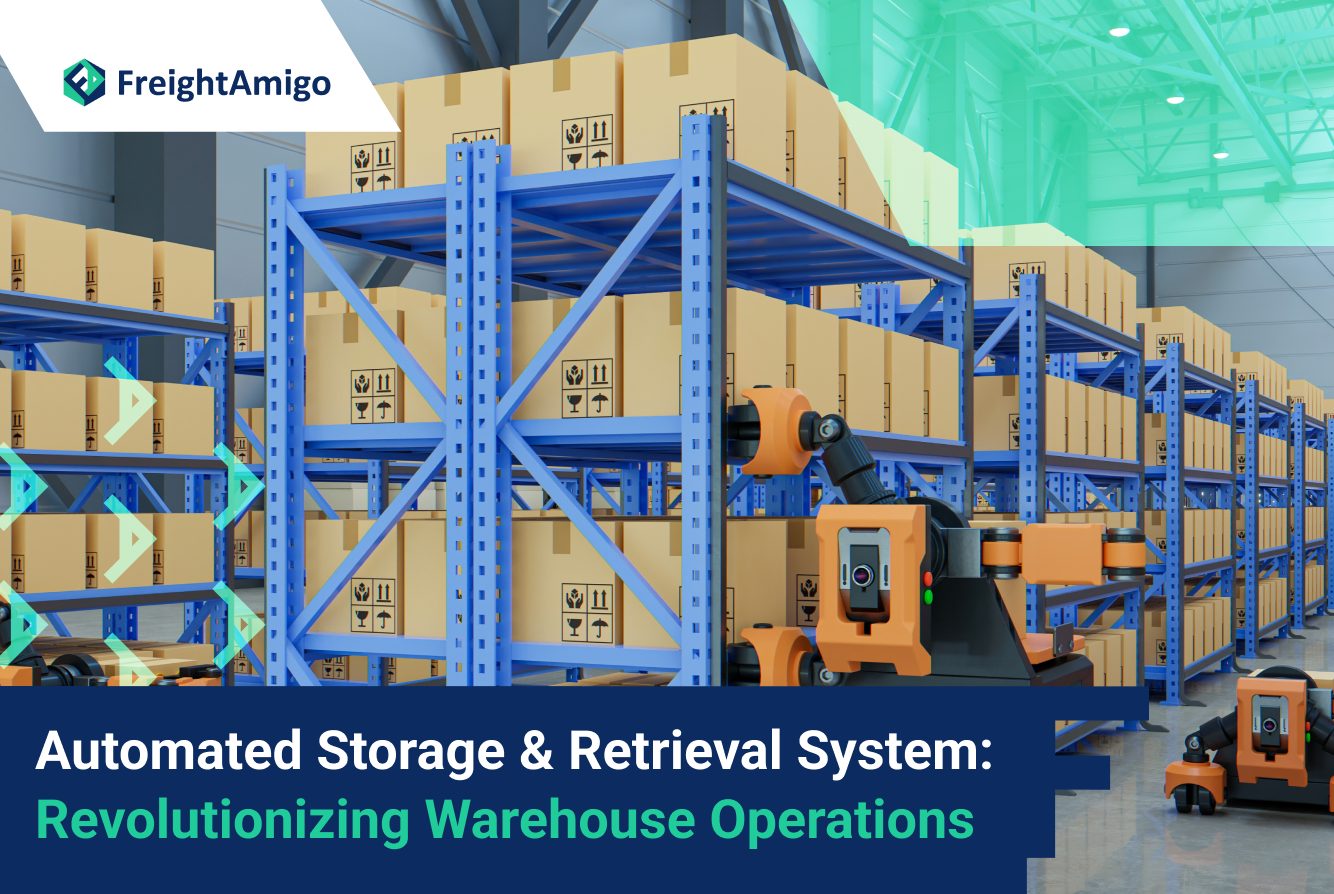In today’s fast-paced business environment, efficient warehouse operations are crucial for the success of any company. One technology that has revolutionized the way warehouses operate is the Automated Storage & Retrieval System (ASRS). By seamlessly integrating logistics services with ASRS technology, businesses can optimize their warehouse operations, enhance supply chain efficiency, and gain a competitive edge in the global marketplace.
Author Name:Tiffany Lee – Marketing Analyst at FreightAmigo
Want to compare the best Express, Air Freight, Sea Freight, Rail Freight & Trucking rates so as to have better control on cost?
What is an AS/RS Automated Storage System?
An Automated Storage and Retrieval System (AS/RS) is a fully automated system that consists of high-rise three-dimensional shelves, stackers, various types of forklifts, warehousing systems, unmanned guided vehicles, control systems, and peripheral equipment. It utilizes advanced robotic technology and computer control to automate the storage and retrieval of goods in a warehouse, following specific principles for goods entering and leaving based on demand. This system eliminates the need for manual labor, reduces errors, and maximizes storage capacity, making it an essential tool for modern warehouses.
Components of Automated Storage Systems:
1. Civil and Public Works Facilities
- Warehouse
- Fire protection systems
- Lighting system
- Powertrain
- Ventilation and heating systems
- Other facilities such as drainage facilities, lightning protection grounding facilities, and environmental protection facilities
2. Mechanical Equipment
- Shelves
- Cases and pallets
- Stacker cranes
- Peripheral handling equipment
3. Electrical and Electronic Equipment
- Detection devices
- Information identification devices
- Controls
- Monitoring and scheduling equipment
- Computer management system
- Data communication equipment
- Large-screen display
Benefits of ASRS
- Increased Efficiency: ASRS enables faster and more accurate order fulfillment, reducing processing time and minimizing errors. It automates the movement of goods within the warehouse, optimizing space utilization and maximizing productivity.
- Real-Time Inventory Visibility: By integrating ASRS technology with logistics services, businesses gain real-time visibility into inventory levels and locations. This enables them to make informed decisions, minimize stockouts, and improve customer satisfaction.
- Enhanced Order Accuracy: The connection between ASRS and logistics services streamlines the order fulfillment process. Automated systems ensure that the right products are picked, packed, and shipped, reducing the risk of errors and enhancing order accuracy.
- Improved Safety: ASRS technology minimizes the need for manual labor, reducing the risk of accidents and injuries in the warehouse. Automated systems are designed with safety features to protect both employees and goods.
How Automated Warehouses Are Categorized?
1. Classification According to Building Form
(1) Integral Type: Refers to the integrated structure of the warehouse shelf, which serves both as a storage system and a supporting structure for the building. Generally, the overall height exceeds 12 meters. This type of warehouse structure is lightweight and earthquake-resistant.
(2) Detached Type: Refers to independent shelves for storing goods inside the building. The height is generally below 12 meters, but can reach 15 to 20 meters. It is suitable for utilizing existing buildings as warehouses or constructing high shelves within factories and warehouses.
2. Classification According to the Form of Cargo Access
(1) Unit Shelf Type: Goods are first placed on pallets or in containers, which are then loaded into the unit shelves.
(2) Mobile Shelf Type: Consists of electric shelves that can move along tracks, with controlled separation between shelves. During operation, the shelves are spread apart, and when not in use, they can be closed, leaving only one working aisle, thus increasing space utilization.
(3) Picking Shelf Type: The picking mechanism is the core component of this type, consisting of in-aisle picking and out-of-aisle picking. “Picking before arrival” refers to picking goods required from the warehouse before they arrive at the warehouse by the stacker. “Picking-to-person” involves the stacker delivering pallets or boxes containing required goods to the picking area. Picking personnel then retrieve the necessary items based on the bill of lading requirements and return the remaining goods to their original locations.
Classification According to the Form of Cargo Structure
(1) Unit Cargo Format Warehouse: Similar to the unit shelf type, the area accounts for approximately one-third of the aisle.
(2) Through-Type: Eliminates the aisles between rows of shelves and replaces them with channels capable of storing multiple cargo units simultaneously. Individual shelves are merged, allowing each layer and column of goods to intersect. Goods are retrieved using an outbound crane at the opposite end, improving warehouse utilization. Depending on how the cargo units move within the aisle, through-type warehouses can be further divided into gravity shelf warehouses and shuttle trolley type shelf warehouses. The former is suitable for warehouses with few varieties and relatively large quantities, as it can store only the same type of goods per inventory channel. The latter allows for crane transport from one stock aisle to another.
(3) Horizontal Rotation Type: Moves back and forth along a circular route on the horizontal plane. Each set of shelves consists of multiple individual containers connected in series by a chain conveyor. The container moves as the conveyor moves, receiving outbound instructions at the operator station and stopping when the container with the required goods reaches the shipping port. This type of shelf is suitable for picking small items and low-frequency operation scenarios.
(4) Vertical Rotation Type: Similar to horizontal rotation shelf warehouses, but with rotation occurring in the vertical plane. This type of racking is suitable for storing long rolls of goods such as carpets, floor leather, film rolls, and cable rolls.
What You Need to Do to Set Up and Use an Automated Warehouse?
Automated warehouses offer unmatched advantages compared to ordinary warehouses. However, certain conditions must be met to set up and utilize an automated warehouse effectively.
1. Frequent and Balanced Goods Inbound and Outbound Operations
Automated warehouses excel in fast and accurate operations, making them suitable for goods with high-frequency warehousing and outbound activities. It is essential to maintain a balanced flow of goods in and out of the warehouse to fully utilize the advantages of automation. Low frequencies or erratic patterns of inbound and outbound storage can hinder the efficiency of automated warehouses. It’s important to note that factors affecting the frequency and equilibrium of warehouse operations are not solely within the warehouse itself but are controlled by inventory, supply, and demand departments. Adequate preparation is necessary when establishing and utilizing automated warehouses.
2. Meeting Special Requirements for Warehouse Construction
The design and construction requirements for automated warehouses are more specialized compared to ordinary warehouses. Since automated warehouses utilize high-rise shelves, the floor needs to have a much higher load-bearing capacity than regular warehouses. The geology of the warehouse construction site must be considered to build a floor capable of withstanding heavy loads. Automated warehouse operations involve stacking cranes that autonomously retrieve and place boxes and pallets from shelves, requiring strict specifications and dimensions for the shelves to ensure smooth operation. The stacking crane has precise requirements for horizontal and vertical deviations during its movements. Additionally, the external specifications and shape of the cargo must remain relatively unchanged. All these special requirements must be carefully considered during the design stage to guarantee the normal operation of the warehouse.
3. Significant One-Time Investment
The construction of an automated warehouse necessitates a substantial one-time investment, involving not only the consumption of materials like steel but also the cost of equipment. Therefore, when considering the construction of automated warehouses, it is crucial to thoroughly assess the financial situation, availability of materials, and equipment.
4. Requirement for a Professional and Technical Team:
Automated warehouses are a specialized warehousing technology that requires an experienced professional team throughout the warehouse’s construction and utilization. Before the construction of an automated warehouse, numerous foundational tasks must be completed, including design, material selection, capital budgeting, and economic analysis and prediction post-production. Installing computer equipment, developing, testing, and implementing warehouse operating procedures, and addressing potential failures all necessitate the expertise of professional computer personnel. Furthermore, the operation management and maintenance of machinery and equipment also require technical professionals.
How Does an ASRS Work?
An ASRS consists of a combination of hardware and software components that work together to automate warehouse operations. Let’s take a closer look at the key elements of an ASRS:
-
Automated Storage and Retrieval Machines (AS/RS Machines)
AS/RS machines are robotic systems that perform the physical tasks of storing and retrieving goods in the warehouse. These machines are equipped with advanced sensors and actuators that enable them to move swiftly and precisely.
-
Storage Racks and Shelves
Storage racks and shelves are designed to maximize space utilization in the warehouse. They provide a structured framework for storing goods and are compatible with AS/RS machines, allowing for seamless integration.
-
Conveyors and Sortation Systems
Conveyors and sortation systems facilitate the movement of goods within the warehouse. They transport items from one location to another, ensuring smooth and efficient operations.
-
Warehouse Management System (WMS)
The Warehouse Management System (WMS) is the brain of the ASRS. It controls and coordinates all the components of the system, including AS/RS machines, storage racks, conveyors, and sortation systems. It receives and processes orders, allocates resources, and monitors inventory levels in real-time.
-
Control Software and Algorithms
Control software and algorithms enable the ASRS to operate efficiently. They optimize the movement of goods, determine the most efficient storage locations, and ensure smooth coordination between different components of the system.
Applications of ASRS
ASRS technology has a wide range of applications across various industries. Some common applications include:
- E-commerce Fulfillment: ASRS enables e-commerce businesses to efficiently manage their inventory and fulfill customer orders quickly and accurately.
- Manufacturing: ASRS optimizes material handling and storage in manufacturing facilities, reducing lead times and improving overall operational efficiency.
- Cold Storage: ASRS is particularly beneficial in cold storage facilities, where temperature-controlled environments require efficient storage and retrieval of goods.
- Pharmaceuticals: The precise and controlled environment provided by ASRS is ideal for storing and handling pharmaceutical products, ensuring compliance with strict regulations.
FreightAmigo and ASRS Empowering Efficient Logistics Operations
The Automated Storage & Retrieval System (ASRS) is a game-changer in the world of warehouse operations. By automating the storage and retrieval of goods, ASRS technology increases efficiency, improves inventory management, and enhances overall supply chain performance. Businesses that embrace ASRS can optimize their warehouse operations, reduce costs, and gain a competitive advantage in today’s fast-paced business landscape.
With the collaboration between FreightAmigo and ASRS, businesses can further enhance their logistics operations, achieve real-time visibility into inventory, and streamline their order fulfillment processes. By leveraging these technologies, companies can unlock new levels of efficiency, accuracy, and customer satisfaction in their warehouse operations.
Investing in an ASRS is a strategic decision that can revolutionize the way businesses operate. By embracing automation and leveraging advanced technologies, companies can future-proof their warehouse operations and stay ahead of the competition.
There are different options for cargo transportation. If you want to choose the most convenient and suitable solution, it is best to have the full support of logistics experts! If you are planning to ship goods overseas, please go to the FreightAmigo page for inquiries.
===
If you have any inquiries on logistics/supply chain, feel free to contact FreightAmigo now:
Chat with us online OR
Phone : +852 28121686
WhatsApp: +852 27467829



